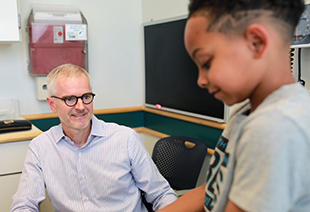Learning Network to Compare Outcomes, Patient Experience of All Three Surgical Kidney Stone Surgeries

When it comes to removing kidney stones in children and adolescents, there’s good news and bad news. The good news is that pediatric urologists can choose among three well-established interventions — ureteroscopy (URS), shockwave lithotripsy (SWL) and percutaneous nephrolithotomy (PCNL). The bad news is there’s scant evidence to guide decisions about which surgery is optimal from a clinical and patient experience standpoint in pediatric patients.
With the incidence of kidney stones on the rise in children and adolescents, it’s more important than ever to address this critical knowledge gap. To that end, Cincinnati Children’s and four other research institutions established the Pediatric KIDney Stone (PKIDS) Care Improvement Network. This community of patients, caregivers and clinicians will perform collaborative studies of kidney stones at over 25 pediatric healthcare systems in North America. William (Bob) DeFoor, MD, MPH, a pediatric urologist at Cincinnati Children’s, serves on the executive committee
The network’s first study, now underway, will compare stone clearance rates and patients’ experiences for ureteroscopy, extracorporeal shockwave lithotripsy, as well as percutaneous nephrolithotomy. It will use a standardized ultrasound protocol to assess stone clearance and surveys to compare patients’ experiences in the postoperative period. Surveys will ask questions related to topics such as urinary symptoms, pain management, anxiety, and surgery’s impact on peer and family relationships.
“Pediatric urologists use fairly robust clinical guidelines based on stone parameters like size, location and other factors, but we don’t know much about how patients are affected by each type of surgery, except anecdotally,” DeFoor says. “The surveys represent new and exciting qualitative research focusing on how each type of surgery impacts patients and families in the postoperative period. These surveys, along with the ultrasound protocol, will help urologists identify techniques that result in the best surgical outcomes for these patients.”
Cincinnati Children’s will likely be a leading enrollee for the study, DeFoor says. The hospital’s Pediatric Stone Center, which opened in 2014 in response to a rise in urolithiasis among pediatric patients, cares for about 700 patients with urinary and kidney stones. It is a joint venture of the Divisions of Pediatric Urology and Nephrology and includes physicians, nurses, dietitians, genetic counselors and social workers. Additional clinicians in the Stone Center include those from emergency medicine, human genetics, diagnostic and interventional radiology and laboratory medicine. The team develops a personalized treatment plan that can include medication and/or surgery, and always includes extensive education and recommendations to help children reduce their risk of recurrent stones and minimize complications.
Enrollment in the three-year study is limited to patients ages 8-21 who have been scheduled for one of the three kidney stone removal surgeries. It is funded by the Patient-Centered Outcomes Research Institute (PCORI grant).

